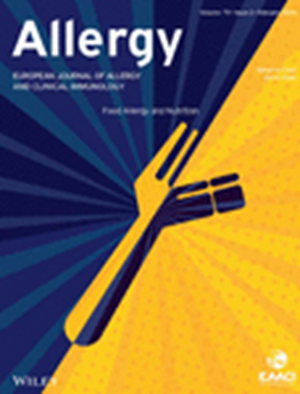IL-4-IL-4Rα轴调节嗅觉神经免疫信号,诱导嗅觉丧失
IF 12.6
1区 医学
Q1 ALLERGY
引用次数: 0
摘要
背景嗅觉丧失是 CRSwNP 诊断标准的一部分。尽管对其机理的了解还不透彻,但抑制 IL-4Rα 和 IL-4/IL-13 信号传导可改善 CRSwNP 患者的嗅觉丧失。在本研究中,我们比较了 IL-4、IL-13 和 IL-4Rα 阻断对小鼠嗅觉的影响,并确定了嗅觉丧失的潜在病理生理机制。为了评估 IL-4 和 IL-13 对嗅觉功能的影响,我们连续 5 天给 BALB/c 小鼠鼻内注射这些细胞因子,并评估它们发现隐藏食物的潜伏期。我们进行了钙摄取试验,以测量体外和体内嗅觉神经元的活性。我们还进行了组织学分析、蛋白质组学、大量 RNA 测序和单细胞 RNA 测序,以评估 IL-4、IL-13 和 IL-4Rα 阻断对嗅上皮的影响,并确定与人类 CRSwNP 患者嗅觉丧失的潜在分子或细胞相关性。我们证明,IL-4-IL-4Rα轴对小鼠嗅觉感觉神经元有直接的功能影响,并在不损害结构完整性的情况下诱发炎性细胞浸润和嗅觉上皮独特分子特征的病理生理调节。此外,对嗅上皮细胞的单细胞分析表明,IL-4-IL-4Rα 信号传导可调节神经元与肥大细胞、巨噬细胞和 NK 细胞之间的串扰,这表明嗅觉损伤与神经炎症之间存在功能性联系。本文章由计算机程序翻译,如有差异,请以英文原文为准。
The IL‐4–IL‐4Rα axis modulates olfactory neuroimmune signaling to induce loss of smell
BackgroundLoss of smell is a part of the diagnostic criteria for CRSwNP. Although the mechanistic understanding is poor, inhibition of IL‐4Rα and IL‐4/IL‐13 signaling improves loss of smell in CRSwNP patients. In the present study, we compare the effects of IL‐4, IL‐13, and IL‐4Rα blockade on murine olfaction and identify the underlying pathophysiological mechanisms of loss of smell.MethodsTo evaluate the effects of IL‐4 and IL‐13 on olfactory function, we administered these cytokines intranasally to BALB/c mice for 5 consecutive days and assessed their latency to find hidden food. Calcium uptake assays were conducted to measure olfactory neuronal activity in vitro and ex vivo. We also performed histological analyses, proteomics, bulk RNA sequencing, and single‐cell RNA sequencing to assess the impact of IL‐4, IL‐13, and IL‐4Rα blockade on the olfactory epithelium and to identify potential molecular or cellular correlations with smell loss in human CRSwNP patients.ResultsHere, we provide evidence for non‐redundant effects of IL‐4 and IL‐13 in olfaction, with loss of smell in mice evoked by intranasal administration of IL‐4, not IL‐13. We demonstrate that an IL‐4–IL‐4Rα axis has a direct functional impact on murine olfactory sensory neurons and evokes inflammatory cell infiltration and pathophysiologic modulation of unique molecular signatures in olfactory epithelium without compromising structural integrity. Furthermore, single‐cell analysis of olfactory epithelium reveals that IL‐4–IL‐4Rα signaling modulates neuronal crosstalk with mast cells, macrophages, and NK cells, suggesting a functional link between olfactory impairment and neuroinflammation.ConclusionCollectively, this study suggests that an IL‐4–IL‐4Rα signaling axis plays a unique pathophysiological role in olfactory dysfunction via direct effect on neurons and modulation of neuroimmune interactions.
求助全文
通过发布文献求助,成功后即可免费获取论文全文。
去求助
来源期刊

Allergy
医学-过敏
CiteScore
26.10
自引率
9.70%
发文量
393
审稿时长
2 months
期刊介绍:
Allergy is an international and multidisciplinary journal that aims to advance, impact, and communicate all aspects of the discipline of Allergy/Immunology. It publishes original articles, reviews, position papers, guidelines, editorials, news and commentaries, letters to the editors, and correspondences. The journal accepts articles based on their scientific merit and quality.
Allergy seeks to maintain contact between basic and clinical Allergy/Immunology and encourages contributions from contributors and readers from all countries. In addition to its publication, Allergy also provides abstracting and indexing information. Some of the databases that include Allergy abstracts are Abstracts on Hygiene & Communicable Disease, Academic Search Alumni Edition, AgBiotech News & Information, AGRICOLA Database, Biological Abstracts, PubMed Dietary Supplement Subset, and Global Health, among others.
 求助内容:
求助内容: 应助结果提醒方式:
应助结果提醒方式:


